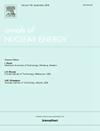整体对称问题中彗星计算的基本数学关系
IF 1.9
3区 工程技术
Q1 NUCLEAR SCIENCE & TECHNOLOGY
引用次数: 0
摘要
本文在COMET入射通量响应展开理论的背景下,导出了具有全局反射和/或旋转对称的堆芯问题的基本数学关系。推导严密地建立了在芯内各种情况下,进、出偏电流通过粗网格表面及其对应的对称表面的膨胀矩之间的关系。然后将这些全局(即全核)对称关系集成到混合随机确定性粗网格传输代码COMET中,使新代码能够模拟部分具有反射和/或旋转对称的反应堆堆芯,而不会增加COMET响应函数库预计算中唯一粗网格的数量。采用两组问题,即一组具有1/8反射对称的程式化PWR基准堆芯构型和一组具有120°旋转对称的三组先进高温堆(AHTR)堆芯构型,对新的COMET代码进行了笛卡尔几何和六边形几何的数值验证。这些基准计算的结果表明,利用全局对称关系仅对一部分堆芯进行建模所预测的堆芯特征值和裂变密度分布与预期的全部堆芯结果非常吻合。对于压水堆和AHTR基准问题,堆芯特征值的差异从0到2 pcm不等。在压水堆和AHTR问题中,裂变密度分布的平均相对差异分别为0.012% ~ 0.014%和0.044% ~ 0.060%。所有的差异都在相应彗星不确定度的三个标准差之内。此外,研究发现,在压水堆和AHTR堆芯配置下,仅对堆芯的对称部分进行建模,COMET的速度分别提高了8倍和3倍。本文章由计算机程序翻译,如有差异,请以英文原文为准。
Underlying mathematical relations for COMET calculations in problems with global symmetry
This paper derives the underlying mathematical relations for reactor core problems with global reflection and/or rotation symmetry within the context of COMET’s incident flux response expansion theory. The derivation rigorously establishes the relationships between the expansion moments of the incoming and outgoing partial current across coarse mesh surfaces and their corresponding symmetric surfaces under various scenarios in the core. These global (i.e., whole-core) symmetry relations are then integrated into the hybrid stochastic deterministic coarse mesh transport code COMET, enabling the new code to model a portion of reactor cores which have reflection and/or rotation symmetry without increasing the number of unique coarse meshes in the precomputation of the COMET response function library. The new COMET code is numerically validated in Cartesian and Hexagonal geometries by using two sets of problems, namely, a set of stylized PWR benchmark core configuration with 1/8th reflection symmetry and a set of three Advanced High Temperature Reactor (AHTR) core configurations with 120° rotation symmetry. Results from these benchmark calculations demonstrate that the core eigenvalues and fission density distributions predicted by modeling only a portion of the core using the global symmetry relations are in excellent agreement with the full core results as expected. The difference in the core eigenvalues varies from 0 to 2 pcm for both the PWR and AHTR benchmark problems. The average relative differences in the fission density distributions range from 0.012% to 0.014% and from 0.044% to 0.060% for the PWR and AHTR problems, respectively. All the discrepancies fall within three standard deviations of the corresponding COMET uncertainties. Additionally, it is found that modeling just the symmetric portion of the cores speed up COMET by eight and three times for the PWR and AHTR core configurations, respectively.
求助全文
通过发布文献求助,成功后即可免费获取论文全文。
去求助
来源期刊

Annals of Nuclear Energy
工程技术-核科学技术
CiteScore
4.30
自引率
21.10%
发文量
632
审稿时长
7.3 months
期刊介绍:
Annals of Nuclear Energy provides an international medium for the communication of original research, ideas and developments in all areas of the field of nuclear energy science and technology. Its scope embraces nuclear fuel reserves, fuel cycles and cost, materials, processing, system and component technology (fission only), design and optimization, direct conversion of nuclear energy sources, environmental control, reactor physics, heat transfer and fluid dynamics, structural analysis, fuel management, future developments, nuclear fuel and safety, nuclear aerosol, neutron physics, computer technology (both software and hardware), risk assessment, radioactive waste disposal and reactor thermal hydraulics. Papers submitted to Annals need to demonstrate a clear link to nuclear power generation/nuclear engineering. Papers which deal with pure nuclear physics, pure health physics, imaging, or attenuation and shielding properties of concretes and various geological materials are not within the scope of the journal. Also, papers that deal with policy or economics are not within the scope of the journal.
 求助内容:
求助内容: 应助结果提醒方式:
应助结果提醒方式:


